Augustus Welby Northmore Pugin (1812-1852)
The Gothic architect AWN Pugin achieved an astonishing volume of work in his 41 year lifespan, and is of strong interest to these pages because of his contributions to architectural ornament, and close collaboration with a variety of sculptors and other artists: his principal work in this respect of course being the Houses of Parliament, where Charles Barry did the grand design, Pugin designed the detail, and the prolific and talented John Thomas was responsible for executing the sculpture.
He trained under his father, Augustus Pugin (1762-1832), born a Frenchman who came to England in the time of the Revolution, worked for John Nash, and published extensively and influentially on Gothic architecture, though his own buildings were few. Eastlake, who wrote a history of the Gothic, notes rather uncharitably that few of the elder Pugin’s pupils followed professions in architecture – the main ones being Benjamin Ferry, Thomas Talbot Bury, and James Pennethorne, the latter of whom turned Classical. The great exception of course, was his son. He developed a fixed taste for medieval art early on, and by age 15 was designing furniture, goldsmiths’ work and plate, then theatre scenery, and then set up a business to ‘manufacture carved ornaments and Gothic decorations of every class’. Both his father, and mother Catherine Welby, died in the early 1830s, and his first wife also. He was thus still very young when after these personal calamities, and the failure of his design business, he turned his main focus to setting up as an architect proper. He also turned to Catholicism, apparently after becoming convinced that only Catholicism could revive true Gothic architecture.
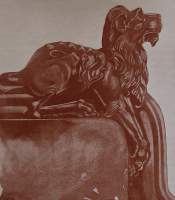 Houses of Parliament, Pugin design for a seat end.
Houses of Parliament, Pugin design for a seat end.
As an architect, he quickly found success, with a patron in the Earl of Shrewsbury, who was Catholic. He made his name with a series of very influential publications, commencing with the True Principles of Gothic Architecture in 1841, An Apology for the Revival of Christian Architecture, 1843, and the Glossary of Ecclesiastical Ornament and Costume in 1844. His practice was in Shrewsbury, then in 1841 he came to London, and then ultimately settled in Ramsgate. He worked for Charles Barry on the details of the Houses of Parliament from the mid 1830s through until almost the end of his life: at the time, some said that his work on this led to his exhaustion and ultimate collapse and death.
Many have said that Pugin was better in his detail and decorative work than as an architect of a whole building, and it is true that when we approach a Pugin building, we look forward to seeing an interior filled with beautiful designs, and if it turns out to be largely bare, we are disappointed rather than looking to appreciate some dry architectural effects of light and space. In these terms then, Pugin’s work is best seen in the Palace of Westminster, above all in the decorations of the House of Lords and the central lobby, but also throughout and in almost every part of the original building.
Of those works he was entirely responsible for as an architect, though there are a few of his major secular buildings such as Scarisbrick Hall which remain, it is his ecclesiastical buildings which are most accessible and have survived best. Though a Catholic, with some of his early churches commissioned by the Earl of Shrewsbury, Pugin also designed a large number of Anglican churches.
In London, his main ecclesiastical work was St George’s Roman Catholic cathedral, in Southwark off the Lambeth Road. But this is not the best example of Pugin’s work: the site was restricted, the cost very much so, meaning a paucity of the amount of detail which Pugin excelled at, and the building was ruined in the war. Although well reconstructed in the 1950s using ‘as much as possible’ of Pugin’s work, and with the three-aisled nave not so different from that shown in pre-war pictures, it does not live and breathe Puginism as we look at it today.
Far more characteristic is another Pugin Cathedral, St Chad’s in Birmingham (1839), with its twin spiky towers which impose a sense of verticality far greater than their height. St Mary’s in Derby was among his very first architectural works, and is not much changed from when he built it (1837-9). Alas, I have not visited St Giles in Cheadle (1840), but pictures of show a superb tower and an interior encrusted with rich ornament. Another work funded by the Earl of Shrewsbury was the Cathedral Church of St Barnabas in Nottingham (1841-44), again with a splendid spire. His Liverpool churches have not fared so well, but in east Manchester is his church at Gorton – St Francis, Gorton Monastery.
In terms of sculpture, Pugin’s buildings certainly gave scope for this, both in terms of internal medieval revival work, and exterior saints in niches and so forth – though so often he was kept to a tight budget that allowed for much less than might be hoped for. As ever, where there is sculptural work, the identities of the sculptors concerned are generally obscure, though I daresay a look at individual church records might reveal much. For stained glass and metal ornament, the important firm of Messrs Hardman was much influenced by Pugin, and his son in law at that firm, John Powell, closely followed his style.
Finally, a word on Pugin’s influence on other architects, which was far greater than that of his father. Above all George Gilbert Scott, with his vast output of public buildings in Gothic style across the country, took his inspiration from Pugin. William Butterfield, the polychromatic Gothicist, and G.E. Street, mainly ecclesiastical but best known for the Law Courts, were also strongly influenced by him, and of his various children by three wives, Edward Welby Pugin followed his father into architecture and completed some of his buildings after his untimely death.
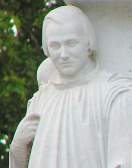
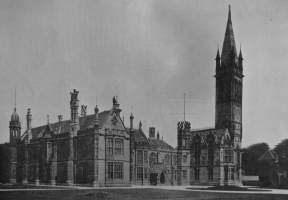 Scarisbrick Hall.
Scarisbrick Hall.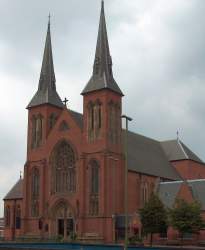 St Chad's Cathedral.
St Chad's Cathedral.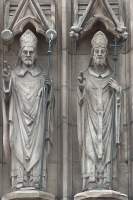 Two of the utterly Gothic figures on St Chad's Cathedral.
Two of the utterly Gothic figures on St Chad's Cathedral.